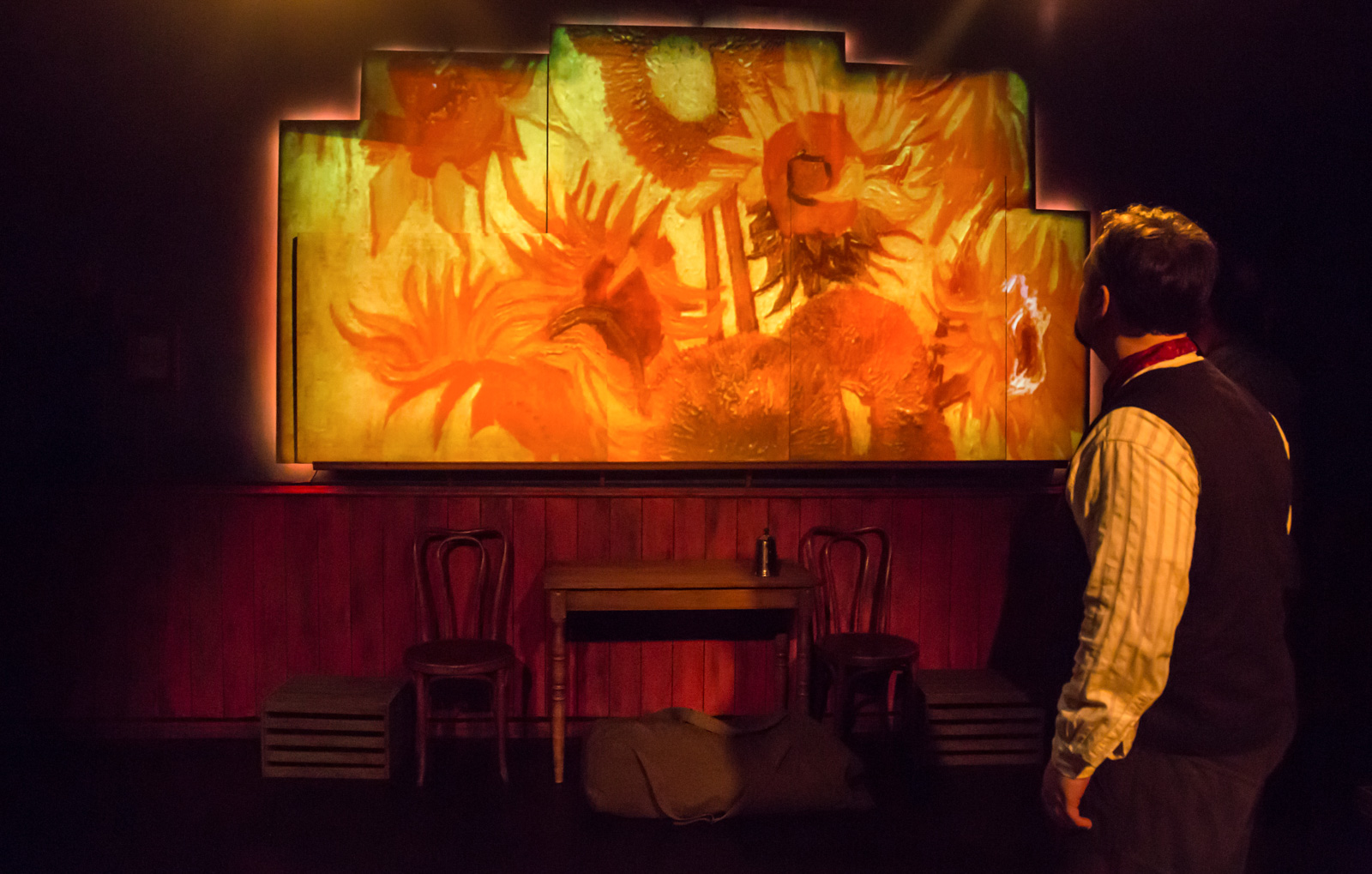Alumnus visual designer uses projection to augment theater production

“The Art Couple” was recently nominated for a Stage Raw Theater Award for alumnus Corwin Evans’ work in video and projection design. One scene in the play features Vincent Van Gogh presenting Paul Gauguin with a painting of sunflowers, where Evans had the projection of the painting zoom in and out and glide across the wall of the stage. (Courtesy of Darrett Sanders)
By Ethan Pak
Aug. 13, 2018 12:03 a.m.
Vincent Van Gogh’s painting of sunflowers glided across the Sacred Fools Theater Company’s walls in “The Art Couple” – all because of a projector.
The play tells the story of Neil Simon writing the first draft of the television series “The Odd Couple.” While leaving for his Catskills cabin with a busboy he meets at a bar, Simon continues to write his draft and discovers the two share a mutual fascination with artists Paul Gauguin and Van Gogh, who turn out to be the main subjects of his first draft. With the awards ceremony slated for Aug. 20, the play was nominated for a Stage Raw Theater Award for Corwin Evans’ work in video and projection design. Evans, a UCLA alumnus, said he tried to ensure his projections are an integral aspect of a scene rather than taking attention away from the play or production themselves.
“(At TED Talks), you’re just throwing something on the wall and talking about it,” Evans said. “When you’re doing art, you want (to give) someone a little bit of room to imagine and put the pieces together and understand something.”
Throughout “The Art Couple,” Evans said the characters discuss many of Van Gogh’s paintings, and he wanted to include the artwork onstage without bulky paintings and frames blocking audience members’ view. He decided to stack several canvas frames on either side of the stage and project the paintings onto the frames, he said. Because of the artistic characteristics of Van Gogh’s paintings, the projections look like the actual paintings, he added.
“The thing about (Van Gogh), his brush strokes are so thick and sumptuous and so detailed that when you project it on canvas, it looks like the painting because there are so many highlights in it; they’re so dimensional and thick,” Evans said. “We got away with so much just projecting those beautiful paintings on canvas.”
Evans’ success in recreating Van Gogh’s paintings is due in part to his collaboration with Andrew Schmedake, the play’s lighting designer. For example, when Van Gogh’s “The Yellow House (The Street)” appears in the play, yellow and amber hues backlight the painting projection and creep along the back wall of the stage to match the painting and to hide the lit square that projectors usually show, Evans said.
For other scenes, such as when Van Gogh presents Gauguin a painting of sunflowers, instead of projecting the painting onto an empty frame, Evans had the projection zoom in and out, said Brendan Hunt, the playwright and actor who portrayed Van Gogh. In order to express Gauguin’s amazement with the painting, the projection also glides across the wall of the stage and appears in front of and behind Gauguin, he added.
“Gauguin had written in his memoirs (that he) saw that painting of sunflowers and was immediately blown away,” Hunt said. “We conveyed what Gauguin was going through looking at the painting, and not just the painting itself.”
Despite the long history of projection, designers are still finding new ways of projecting by incorporating trending technologies, such as new types of LED screens and projectors, said Jeff Burke, associate dean of technology and innovation at the UCLA School of Theater, Film and Television. Designers are also increasingly using real-time 3D engines to project 3D models onto a stage or digital images to coat physical objects in a scenic set, he said.
Although designers utilize current technologies, Evans said they are still experimenting to determine the different limitations and possibilities in projection. Even with a backdrop that can change colors or transition from night to day, designers have to test different combinations to see what works.
“You have a whole new dimension of variables you can experiment with to more effectively tell your story or evoke the experience you’re hoping to provoke,” Evans said. “It’s another tool in the toolkit but we’re still learning how to use it.”

